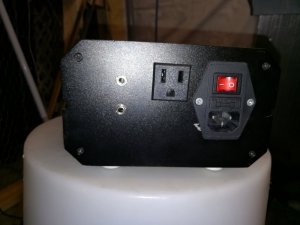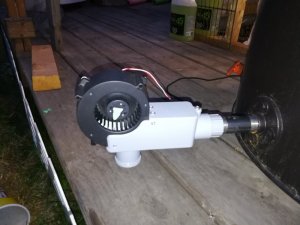Hi guys.
Last summer I built 2 UDS smokers, yeah I only need one but I was bored and it's just as easy to build 2 at once. Both are basically the same they both start with three 3/4" intakes around the backs and 2" chimneys. What differs them is one has both a 3/4 and 1" air intake stack with ball valves towards the front. And the second only has one 1" intake stack. For the most part both like to stay around 250F, and don't like the lower temperatures. I would like to smoke around 225F but I have to fight to stay that low.
So I'm chasing the temps all night until early morning when the dew sets in and the outside temps drop and I'm fighting to stay alive this is usually half way through the cook. So the sweet spot is around 250F I guess I could live with that but the dying out at 4:30-5am sucks. So again I got bored over the winter and built a PID with a fan to babysit through the night. Today I finally did a test smoke of a small sirloin roast no big deal. I set the PID to 225F and set the auto tune, up she rose to 280F and it took 2hrs to drop back to 225F, fan kicks in and slowly back up to 250F then creeps up to 265F over the next 4hrs. All the intakes are closed the fan housing I built has a flapper to limit the natural draw of air.
I know this is content heavy but the more info I give you the better help you all can give me.
My question is with the natural draft out the chimney can air still draw down to stoke the coal ( by the way I'm using kingfords lump) and I run the 2" chimney full open and rely on the intake for control.




Last summer I built 2 UDS smokers, yeah I only need one but I was bored and it's just as easy to build 2 at once. Both are basically the same they both start with three 3/4" intakes around the backs and 2" chimneys. What differs them is one has both a 3/4 and 1" air intake stack with ball valves towards the front. And the second only has one 1" intake stack. For the most part both like to stay around 250F, and don't like the lower temperatures. I would like to smoke around 225F but I have to fight to stay that low.
So I'm chasing the temps all night until early morning when the dew sets in and the outside temps drop and I'm fighting to stay alive this is usually half way through the cook. So the sweet spot is around 250F I guess I could live with that but the dying out at 4:30-5am sucks. So again I got bored over the winter and built a PID with a fan to babysit through the night. Today I finally did a test smoke of a small sirloin roast no big deal. I set the PID to 225F and set the auto tune, up she rose to 280F and it took 2hrs to drop back to 225F, fan kicks in and slowly back up to 250F then creeps up to 265F over the next 4hrs. All the intakes are closed the fan housing I built has a flapper to limit the natural draw of air.
I know this is content heavy but the more info I give you the better help you all can give me.
My question is with the natural draft out the chimney can air still draw down to stoke the coal ( by the way I'm using kingfords lump) and I run the 2" chimney full open and rely on the intake for control.








